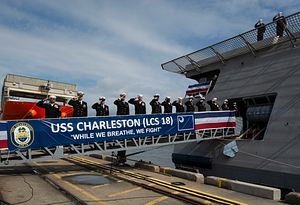The U.S. Navy commissioned the newest Independence-class Littoral Combat Ship (LCS), the USS Charleston (LCS 18), during a ceremony at the Columbus Street Terminal in Charleston, South Carolina on March 2. The USS Charleston is the 16th LCS to enter service with the U.S. Navy and the ninth of the Independence-class variant.
It is the sixth warship the U.S. Navy has commissioned in the past 60 days and one of 12 ships slated to be commissioned in 2019. In 2018, five littoral combat ships were handed over to the service, while three are scheduled for delivery in 2019. The latest LCS to be commissioned in 2019 was the USS Tulsa on February 27.
The U.S. Navy’s LCS fleet is divided into the Independence and Freedom variants. Construction of the Freedom class is headed by Lockheed Martin at the Fincantieri Marinette Marine (FMM) shipyard in Marinette, Wisconsin, whereas the construction of Independence-class ships is managed by Austal USA in Alabama. The Austal and Lockheed shipyards are optimized to produce two littoral combat ships per year.
The USS Charleston was built by Austal USA. The warship was laid down in June 2016 and launched in September 2017. The LCS successfully completed acceptance trials in the Gulf of Mexico in July 2018, overseen by the he U.S. Navy’s Board of Inspection and Survey, and marked the last hurdle before the ship was delivered to the U.S. Navy in August of the same year.
“USS Charleston has the ability to tackle asymmetrical threats like mines, quiet diesel submarines, and at the same time, fast surface ships,” South Carolina Senator Tim Scott said during the commission ceremony. “We have been blessed to have our Charleston defending this nation.” However, according to report by the Pentagon’s office of Operational Test and Evaluation from January 2018, both the Independence and Freedom variants are not suitable for high-intensity combat.
As I noted in the past:
[W]ith 40 percent of the hull reconfigurable, both LCS variants use an open architecture design, enabling the warships to be fitted with interchangeable so-called mission packages providing capabilities for surface warfare (SUW), anti-submarine warfare (ASW), and mine countermeasures (MCM) missions in the littoral zone. The ASW warfare package is expected to become available to the fleet in 2019, while the MCM package will be available in 2020.
Additionally, I explained:
Each LCS is also expected to be equipped with the Surface-to-Surface Missile Module, a 24-shot AGM-114L Longbow Hellfire missiles vertical launch system, with initial operational capability expected by the end of this year. Additionally, both LCS variants are also armed with a 57-millimeter naval gun and a 11-cell Raytheon RIM-116B SeaRAM missile-defense system.
The USS Charleston will now transit to join LCS Squadron 1 and 10 other ships of the class currently homeported at Naval Base San Diego, California.

































